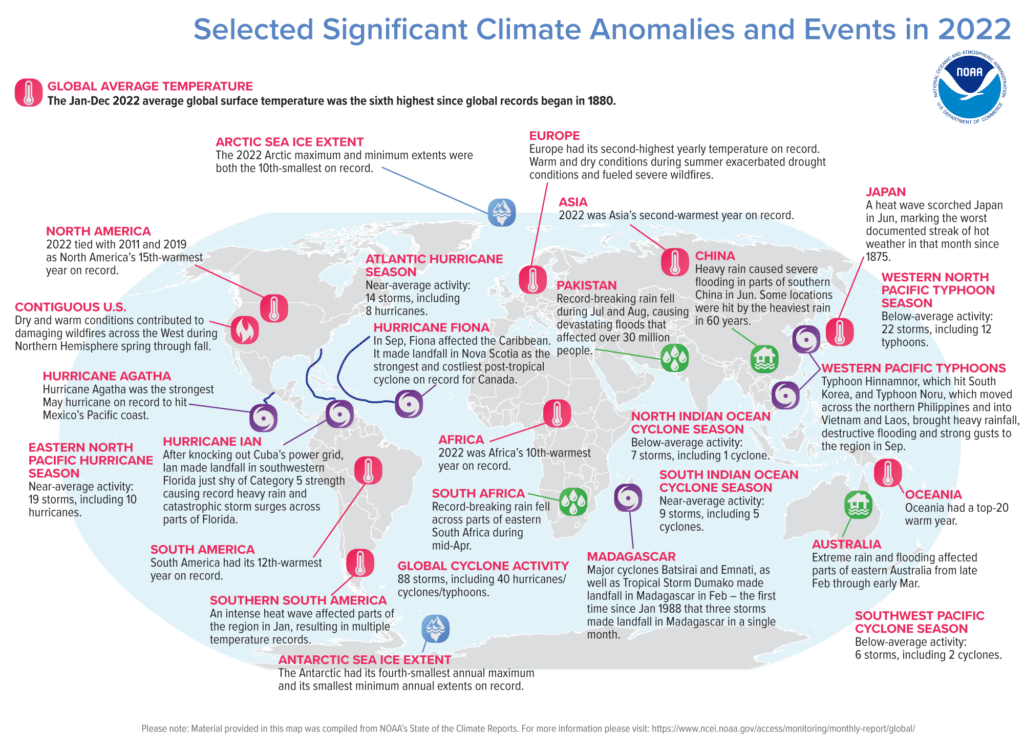
NOAA’s 2022 global climate report — broken down with Currently meteorologist Megan Montero.
The National Oceanic and Atmospheric Administration released its 2022 global climate report last week.
Earth had its 6th-warmest year on record (from 1880 to 2022) in 2022, according to the report. The average global surface temperature was 1.55 degrees F (0.86 degrees C) above the 20th-century average. December’s global surface temperature was 1.44 degrees F (.8 degrees C) above average, making it the eighth-warmest December in the 143-year-long NOAA record.
“All of this is to be expected,” Currently’s Chief Meteorologist Megan Montero said. “Scientists, meteorologists, and climatologists have been talking for a long time, since the early 2000s, about how we’re going to see a warming like this.”
Montero continued: “The thing that we weren’t expecting is that this wasn’t supposed to happen until the 2030s, so we’re about 10 years ahead of what we even predicted, which obviously, isn’t good.”
Montero said that warmer temperatures will lead to more extended periods of drought, longer fire seasons, and more intense hurricanes. We could even see longer periods of cold spells as well as heavy snowstorms.

NOAA 2022 global climate report climate anomalies
“Just because it’s global warming doesn’t necessarily mean that we’re just going to see extended periods of heat,” Montero explained.
Oceans continued to warm as well. In fact, the global ocean heat content (OHC) reached a record high, surpassing 2021’s record. The four highest OHCs have all occurred in the last four years, from 2019 to 2022.
“With more oceans warming, you’re going to get more intense storms, specifically hurricanes,” Montero said. “What we have found is that even if the sea surface temperature changes by 1 degree C, it can actually change our entire way of weather. That one degree makes a big difference in our hurricane season and it plays into whether we’re in an El Niño or La Niña. It is going to have a large impact.”
The polar sea ice ran low, too. The 2022 annual Antarctic sea ice cover was at a near-record low at 4.09 million square miles, as only 1987 had a smaller annual extent. The 2022 annual Arctic sea cover was about 4.13 million square miles, the 11th-smallest annual average in the 1979-2022 record.
Montero said that the Arctic sea ice melt affects our weather as well. As it melts, we get an increased volume of water released into the atmosphere, resulting in higher flood risk in some places. It also throws the balance of the atmosphere off in other areas.
“It’s unprecedented,” Montero said. “We don’t know how to account for that much loss of status, but [meteorologists and climate scientists] are studying it.”
2022 also saw 88 named storms, near the 1991-2020 average. Of those, 40 reached tropical cyclone strength, with winds of 74 mph or higher, and 17 reached major tropic cyclone strength, with winds of 111 mph or higher. The global accumulated cyclone energy (ACE) — which measures the strength, frequency, and duration of tropical storms — was the fourth lowest since 1981.
Montero said that as a community, we need to move past the point where we’re just “shocked” by this information. Instead, she urges people to mobilize and take action in whatever ways they can.
“What I encourage most people to do is to move to a place of acceptance and then once we’re in a place of acceptance, ask: ‘What’s next? What can I do to help with climate change and climate mitigation efforts?’ If that is a climate reparations program, or paying a service to plant more trees, or even planting more trees ourselves, do that. We must invest in eco-friendly and sustainable efforts, and together we can actually mitigate the effects of climate change.”
